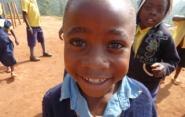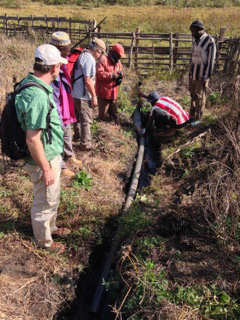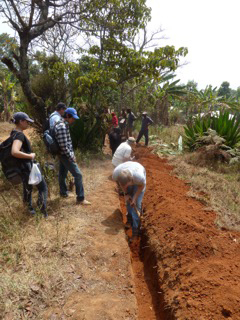The Key to Engineering Without Borders? Collaboration and Commitment

For the Yale chapter of Engineers Without Borders (EWB), success is measured in relationships. For example, although the group finished their first project in Cameroon — designing and overseeing the construction of a gravity-fed water distribution system in the village of Kikoo — in 2011, they still visit the village each time they return to the country.

“The Kikoo villagers are friends, so we always stop in and see how things are going,” says Dave Sacco, a civil engineer and Yale alumnus who has served as EWB’s professional mentor since the club first formed 11 years ago. “And it’s really striking how much development is going on in the village. People with historic ties to the community who moved away are coming back and building homes because they now have a clean water source. It’s a desirable place to live, and people feel very positive about the community.”
Maintaining that relationship has also been possible for the group because their current project is in the nearby village of Rohvitangitaa. When community members first approached EWB in 2010, Roh (as it’s often shortened) already had an NGO-built water system, but it was not serving the community well: it had failing pipes, no storage system, and was unevenly serving only a small portion of the community. EWB, after working with Roh to establish a well-organized water committee that represented the whole village, agreed to create a new system that would successfully deliver water to the entire community, a project has been a prime focus of EWB’s outreach efforts since 2012.
Now that focus is beginning to pay off, and already the Roh project is having a noticeable impact, says associate professor of chemical & environmental engineering Jordan Peccia, who is also the faculty advisor for EWB. “The main purpose of EWB — even more than opportunities to travel internationally, meet new people, and gain new experiences — has always been to do something tangible that makes a difference in the world,” he said. “It’s becoming clear that the Roh project, like the Kikoo project before it, is doing just that.”
In Search of a Second Stream
Each day that they’re onsite in Roh, the students divide into two teams, one to perform a technical assessment and the other to promote public health. Although each team’s specific tasks change as the project develops, their fundamental identities remain the same. The technical assessment team, for example, ensures that the water system is being built according to plan while also using their engineering expertise to adapt the plan as necessary. “We start by walking along the system with the construction people and the water committee to identify any inconsistencies or problems,” says James Doss-Gollin, the EWB co-president along with Lauren Gardanier. “Perhaps we’ll discover that someone has extended a field over a pipeline and might hit it with a hoe, or maybe a pipeline has been rerouted to avoid a large rock and we need to ensure that the change won’t damage the system’s functionality.”

The technical analysis also becomes a teaching tool for demonstrating the principles of fluid mechanics and hydraulics, surveying, and even the CAD software used to develop the original designs. Workshops on these topics held during EWB meetings throughout the year also open up EWB membership to non-engineers and freshmen, laying the foundation interdisciplinary connections..
However, being a part of EWB is about much more than applying scientific principles. “Many of the variables for projects like this have nothing to do with math, nothing to do with engineering,” says Sacco. “Instead, we’re discussing community perception and land rights, topics that can change the feasibility of proposed development strategies and that aren’t usually covered in an engineering curriculum.”
On this latest trip, the technical team faced with the task of finding an additional groundwater source to bolster the system’s current spring, which seems to be diminishing. “But as with every trip, what we think we’re going to get done and what we actually get done are not the same thing,” explains Sacco. Although the team was able to identify ahead of time a number of possible water sources, all of them were dismissed as unfeasible during the course of the trip, and the team instead found another source entirely. “Which is about par for the course,” Sacco adds. “Although it wasn’t what we expected to accomplish, nonetheless we found information that allows us to move forward.”
Public Health is an Engineering Problem
The public health team works in tandem with the technical assessment team to ensure that not only are the residents of Roh getting a source for clean water, but also that they are fully reaping the benefits of that water source. That means seeing both how the water is used after it leaves the distribution system as well as quantifying the project’s health impact.

“It’s funny because when I think about EWB, I think of health surveys,” says Laura Skrip, a doctoral student in the School of Public Health who has been working with the group for nearly four years. “I was brought on board because we wanted to develop a baseline before and after assessment in this community regarding waterborne diseases. But we soon realized there’s much more opportunity for health education.”
Skrip’s team delivers that education during door-to-door visits to as many houses in the village as possible and during lessons in the schools, efforts that are already making a noticeable difference. For example, a big contributor to water contamination identified by EWB in previous visits was point-of-use contamination — though clean water leaves the distribution system, it’s full of bacteria by the time it’s transported home in storage vessels. That’s still somewhat the case, though EWB recently found the cleanliness of the stored water seems to have improved because the villagers have increased their cleaning and usage of lids on their storage vessels.
In response, the public health team used the most recent trip to further eliminate a different source of contamination. “Many of the Roh residents have gotten good about using soap and keeping a lid on top—but when they take a drink, they scoop a communal cup right into the bucket between each person sipping from it,” says Skrip. “So we went to the schools, and we put food coloring in a cup. Then we pretended that this cup is dirty, that so-and-so is sick or dropped it on the ground, and when we dip the cup in the water, the dye spreads around. All the kids’ jaws dropped.”
Skrip adds that although everyone on an EWB trip spends time on both teams, by the end of the trip it’s clear which team each person prefers. And she’s been happy to find the students applying their engineering skills to the public health problems — in trying to eliminate storage vessel contamination, team members have explored passive chlorination systems, sealed water cooler−like vessels that prevent dipping into buckets entirely, and source-tracking data collection.
All of these ideas, however, are on top of the health education — not instead of it. “The students are actively engaged in coming up with posters for hand washing, and they do an excellent job considering the cultural contexts for motivating people,” says Skrip. “This last time, people started hanging our posters in their homes before we even left, and because of our previous outreach, people are reporting fewer stomach-related diseases and less money spent at the local health center.”
A Sustainable Model
As the reduction in waterborne illnesses suggests, EWB’s success is most apparent in what happens between EWB visits. The public health team, for example, teaches people about bacteria while they’re there, then leaves behind all of their lesson plans and handouts, along with instructions for replicating the demonstrations; what’s more, on multiple occasions EWB’s loyal translators have taken on the role of health leaders by sharing what they learned at community meetings. Similarly, although the Yale group designed the water distribution system, the villagers of Kikoo and Roh have taken on the responsibility of building the system under the supervision of a nearby technician.

“We’re the funders, the designers, the people who check up on it — but they’re building it,” says Sacco. “In 2013, when we’d just begun building their water storage tank, there was a lot of excavation and a lot of moving materials and mixing concrete. And yet with only a few days notice, 30 volunteers came out to work hard in the hot sun. With just shovels and picks, villagers in Kikoo dug about nine kilometers of trench.”
However, while the labor is an unpaid communal effort, EWB pays for the materials through their own fundraising efforts. Over the years, the group has developed a loyal donor base and has additionally won outreach grants to support their collaborations in Kikoo and Roh. And the people spurring those efforts are the team’s own best success story, says Doss-Gollin. “Behind the scenes, people are updating the website with pictures and exciting content, keeping all contact information accurate, writing thank you letters to previous donors,” he said. “That’s all so important.”
In that sense, EWB is much more than a way for Yale students to travel to Cameroon for two weeks of labor. Rather, the group’s real work, says Peccia, “happens throughout the semester and is largely done by people who have never and will never go to Cameroon. It’s not tourism in the developing world — it’s a commitment to fundraising and design that takes year-round effort.”

